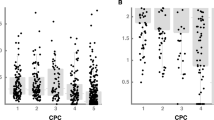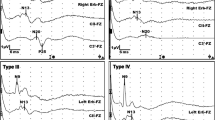Abstract
Objective
Many tests have been used to predict outcome following severe brain injury. We compared predictive powers of clinical examination (pupillary responses, motor responses and Glasgow Coma Scale, GCS), electroencephalography (EEG) and computed tomography (CT) to that of somatosensory evoked potentials (SEPs) in a systematic review.
Materials and methods
Medline (1976–2002) and Embase (1980–2002) were searched, manual review of article reference lists was conducted, and authors were contacted. We selected 25 studies addressing the prediction of outcome after severe brain injury using SEPs and either GCS, EEG, CT, pupillary or motor responses. Outcomes were determined for patients with normal or bilaterally absent SEPs and graded measures of GCS, EEG, CT, pupillary responses or motor responses. For favourable outcome prediction SEPs were superior in sensitivity, specificity and positive and negative predictive values, except for pupillary responses which had superior sensitivity and GCS which had higher specificity. SEPs had superior summary receiver operating characteristic curves, with the exception of motor responses, and superior ratio of odds ratios. For unfavourable outcome prediction SEPs were superior to the other tests in sensitivity, specificity and positive and negative predictive values, except for motor and pupillary responses, GCS and CTs which had superior sensitivity. All SEP summary receiver operating characteristic curves and pooled ratio of odds ratios were superior.
Conclusions
Although imperfect, SEPs appear to be the best single overall predictor of outcome. There is sufficient evidence for clinicians to use SEPs in the prediction of outcome after brain injury.

Similar content being viewed by others
References
Zandbergen EGJ, de Haan RJ, Stoutenbeek CP, Koelman JHTM, Hijdra A (1998) Systematic review of early prediction of poor outcome in anoxic-ischaemic coma. Lancet 352:1808–1812
Carter BG, Butt W (2001) A review of the use of somatosensory evoked potentials (SEPs) in the prediction of outcome after severe brain injury. Crit Care Med 29:178–186
Irwig L, Macaskill P, Glasziou P, Fahey M (1995) Meta-analytic methods for diagnostic test accuracy. J Clin Epidemiol 45:119–130
Moses LE, Shapiro D, Littenberg B (1993) Combining independent studies of a diagnostic test into a summary ROC curve: data analytic approach and some additional considerations. Stat Med 12:1293–1316
DerSimonian R, Laird NM (1986) Meta-analysis in clinical trials. Control Clin Trial 7:177–188
Anderson DC, Bundlie S, Rockswold GL (1984) Multimodality evoked potentials in closed head trauma. Arch Neurol 41:369–374
Bassetti C, Bomio F, Mathis J, Hess CW (1996) Early prognosis in coma after cardiac arrest: a prospective clinical, electrophysiological, and biochemical study of 60 patients. J Neurol Neurosurg Psychiatry 61:610–615
Beca J, Cox PN, Taylor MJ, Bohn D, Butt W, Logan WJ, Rutka JT, Barker G (1995) Somatosensory evoked potentials for prediction of outcome in acute severe brain injury. J Pediatr 126:44–49
Cant BR, Hume AL, Judson JA, Shaw NA (1986) The assessment of severe head injury by short-latency somatosensory and brain-stem auditory evoked potentials. Electroencephalogr Clin Neurophysiol 65:188–195
Chen R, Bolton CF, Young GB (1996) Prediction of outcome in patients with anoxic coma: a clinical and electrophysiologic study. Crit Care Med 24:672–678
DeGiorgio CM, Rabinowicz AL, Gott PS (1993) Predictive value of P300 event-related potentials compared with EEG and somatosensory evoked potentials in non-traumatic coma. Acta Neurol Scand 87:423–427
Facco E, Baratto F, Munari M, Dona B, Liviero MC, Behr AU, Giron GP (1991) Sensorimotor central conduction time in comatose patients. Electroencephalogr Clin Neurophysiol 80:469–476
Facco E, Munari M, Dona B, Baratto F, Fiore D, Behr AU, Giron G (1991) Spatial mapping of SEP in comatose patients: improved outcome prediction by combined parietal N20 and frontal N30 analysis. Brain Topogr 3:447–455
Gutling E, Gonser A, Imhof H-G, Landis T (1995) EEG reactivity in the prognosis of severe head injury. Neurology 45:915–918
Judson JA, Cant BR, Shaw NA (1990) Early prediction of outcome from cerebral trauma by somatosensory evoked potentials. Crit Care Med 18:363–368
Hollerbach S, Kullmann F, Bartsch H, Lögl C, Geissler A, Zeuner M, Leser HG, Schölmerich J (1995) Prediction of outcome in resuscitated patients by clinical course and early somatosensory-evoked potentials. A comparison with the Glasgow coma scale (GCS) and cranial-computed tomography (CCT). Clin Intensive Care 6:219–227
Hutchinson DO, Frith RW, Shaw NA, Judson JA, Cant BR (1991) A comparison between electroencephalography and somatosensory evoked potentials for outcome prediction following severe head injury. Electroenceph Clin Neurophysiol 78:228–233
Madl C, Grimm G, Kramer L, Yeganehfar W, Sterz F, Schneider B, Kranz A, Schneeweiss B, Lenz K (1993) Early prediction of individual outcome after cardiopulmonary resuscitation. Lancet 341:855–858
Nakabayashi M, Kurokawa A, Yamamoto Y (2001) Immediate prediction of recovery of consciousness after cardiac arrest. Intensive Care Med 27:1210–1214
Pohlmann-Eden B, Dingethal K, Bender H-J, Koelfen W (1997) How reliable is the predictive value of SEP (somatosensory evoked potentials) patterns in severe brain damage with special regard to the bilateral loss of cortical responses. Intensive Care Med 23:301–308
Rothstein TL, Thomas EM, Sumi SM (1991) Predicting outcome in hypoxic-ischaemic coma. A prospective clinical and electrophysiological study. Electroenceph Clin Neurophysiol 79:101–107
Rumpl E, Prugger M, Gerstenbrand F, Hackl JM, Pallua A (1983) Central somatosensory conduction time and short latency somatosensory evoked potentials in post-traumatic coma. Electroencephalogr Clin Neurophysiol 56:583–596
Sandroni C, Barelli A, Piazza O, Proietti R, Mastria D, Boninsegna R (1995) What is the best test to predict outcome after prolonged cardiac arrest? Eur J Emerg Med 2:33–37
Taylor MJ, Farrell EJ (1989) Comparison of the prognostic utility of VEPs and SEPs in comatose children. Pediatr Neurol 5:145–150
Whittle IR, Johnston IH, Besser M (1987) Short latency somatosensory-evoked potentials in children. III. Findings following head injury. Surg Neurol 27:29–36
Ying Z, Schmid UD, Schmid J, Hess CW (1992) Motor and somatosensory evoked potentials in coma: analysis and relation to clinical status and outcome. J Neurol Neurosurg Psychiatry 55:470–474
Cheliout-Heraut F, Durand MC, Clair B, Gajdos P, Raphaël JC (1992) Prognosis value of evoked potentials in the postanoxic comas in adult. Neurophysiol Clin 22:269–280
Maurer E, Milewski P (1998) Usefulness and diagnostic value of evoked potentials in surgical ICU patients with neurological deficits. Anasthesiol Intensivmed Notfallmed Schmerzther 33:430–440
Parain D, Devaux AM, Proust B (1989) The contribution of EEG and evoked potentials in the post-anoxic prognosis of coma in children. Neurophysiol Clin 19:489–494
Riffel B, Stöhr M, Graser W, Trost E, Baumgärtner H (1989) Early outcome prediction in patients with severe head injury by Glasgow Coma Score and evoked potentials. Anaesthesist 38:51–58
Anonymous (1994) Guideline 9. Guidelines on evoked potentials. J Clin Neurophysiol 11:40–73
Mauguiere F, Allison T, Babiloni C, Buehner H, Eisen AA, Goodin DS, Jones SJ, Kakigi R, Matsuoka S, Nuwer M, Rossini PM, Shihasaki H (1999) Somatosensory evoked potentials. Electroencephalogr Clin Neurophysiol Suppl 52:79–90
Shapiro DE (1999) The interpretation of diagnostic tests. Stat Methods Med Res 8:113–134
Begg CB, McNeil BJ (1988) Assessment of radiologic tests: control of bias and other design considerations. Radiology 167:565–569
Zweig MH, Campbell G (1993) Receiver-operating characteristic (ROC) plots: a fundamental evaluation tool in medical research. Clin Chem 39:561–577
Irwig L, Tosteson ANA, Gatsonis C, Law J, Colditz G, Chalmers TC, Mosteller F (1994) Guidelines for meta-analyses evaluating diagnostic tests. Ann Intern Med 120:667–676
De Meirleir LJ, Taylor MJ (1987) Prognostic utility of SEPs in comatose children. Pediatr Neurol 3:78–82
Lindsay KW, Carlin J, Kennedy I, Fry J, McInnes A, Teasdale GM (1981) Evoked potentials in severe head injury—analysis and relation to outcome. J Neurol Neurosurg Psychiatry 44:796–802
Lindsay K, Pasaglou A, Hirst D, Allardyce G, Kennedy I, Teasdale G (1990) Somatosensory and auditory brain stem conduction after head injury: a comparison with clinical features in prediction of outcome. Neurosurgery 26:278–285
Greenberg RP, Becker DP, Miller JD, Mayer DJ (1977) Evaluation of brain function in severe head trauma with multimodality evoked potentials. II. Localization of brain dysfunction and correlation with post-traumatic neurological condition. J Neurosurg 47:163–177
Rappaport M, Hopkins HK, Hall K, Belleza T (1981) Evoked potentials and head injury. 2. Clinical applications. Clin Electroencephalogr 12:167–176
Cusumano S, Paolin A, Di Paolo F, Boccaletto F, Simini G, Palermo F, Carteri A (1992) Assessing brain function in post-traumatic coma by means of bit-mapped SEPs, BAEPs, CT, SPET and clinical scores. Prognostic implications. Electroencephalogr Clin Neurophysiol 84:499–514
De Weerd AW, Groenveld C (1985) The use of evoked potentials in the management of patients with severe cerebral trauma. Acta Neurol Scand 72:489–494
Madl C, Kramer L, Domanovitis H, Woolard RH, Gervais H, Gendo A, Eisenhuber E, Grimm G, Sterz F (2000) Improved outcome prediction in unconscious cardiac arrest survivors with sensory evoked potentials compared with clinical assessment. Crit Care Med 28:721–726
Sherman AL, Tirschwell DL, Micklesen PJ, Longstreth WT, Robinson LR (2000) Somatosensory potentials, CSF creatine kinase BB activity, and awakening after cardiac arrest. Neurology 54:889–894
Berek K, Lechleitner P, Luef G, Felber S, Saltuari L, Schinnerl A, Traweger C, Dienstl F, Aichner F (1995) Early determination of neurological outcome after prehospital cardiopulmonary resuscitation. Stroke 26:543–549
Pfurtscheller G, Schwarz G, Gravenstein N (1985) Clinical relevance of long-latency SEPs and VEPs during coma and emergence from coma. Electroencephalogr Clin Neurophysiol 62:88–98
Gutling E, Gonser A, Imhof H-G, Landis T (1994) Prognostic value of frontal and parietal somatosensory evoked potentials in severe head injury: a long-term follow-up study. Electroencephalogr Clin Neurophysiol 92:568–570
Gutling E, Gonser A, Regard M, Glinz W, Landis T (1993) Dissociation of frontal and parietal components of somatosensory evoked potentials in severe head injury. Electroencephalogr Clin Neurophysiol 88:369–376
Stelzl T, von Bose MJ, Hogl B, Fuchs H-H, Flugel KA (1995) A comparison of the prognostic value of neuron-specific enolase serum levels and somatosensory evoked potentials in 13 reanimated patients. Eur J Emerg Med 2:24–27
Schreiner A, Pohlmann-Eden B (1999) Cerebral hypoxia after cardiopulmonary resuscitation. Lancet 353:750–751
Narayan RK, Greenberg RP, Miller JD, Enas GG, Choi SC, Kishore PRS, Selhorst JB, Cutz HA, Becker DP (1981) Improved confidence of outcome prediction in severe head injury. A comparative analysis of the clinical examination, multimodality evoked potentials, CT scanning and intracranial pressure. J Neurosurg 54:751–762
Greenberg RP, Newlon PG, Becker DP (1982) The somatosensory evoked potential in patients with severe head injury: outcome prediction and monitoring of brain function. Ann NY Acad Sci 388:683–688
Sleigh JW, Havill JH, Frith R, Kersei D, Marsh N, Ulyatt D (1999) Somatosensory evoked potentials in severe traumatic brain injury: a blinded study. J Neurosurg 91:577–580
Kane NM, Curry SH, Rowlands CA, Manara AR, Lewis T, Moss T, Cummins BH, Butler SR (1996) Event-related potentials-neurophysiological tools for predicting emergence and early outcome from traumatic coma. Intensive Care Med 22:39–46
Shewmon DA, DeGiorgio CM (1989) Early prognosis in anoxic coma. Reliability and rationale. Neurol Clin 7:823–843
Adams E, Kane N, Boyd S, Kerr S (1996) Somatosensory evoked potentials: predictors of outcome in children with severe brain injury. J Pediatr 128:438–439
Attia J, Cook DJ (1998) Prognosis in anoxia and traumatic coma. Crit Care Clin 14:497–511
Bohn D (1993) Tools for predicting outcome in the neurologically injured child. Crit Care Med 21 [Suppl]:S332–S333
Diringer MN (1992) Early prediction of outcome from coma. Curr Opin Neurol Neurosurg 5:826–830
Facco E, Zuccarello M, Pittoni G, Zanardi L, Chiarnadra M, Davia G, Giron GP (1986) Early outcome prediction in severe head injury: comparison between children and adults. Childs Nerv Syst 2:67–71
Acknowledgements
We thank Professor John Carlin and Professor Frank Shann for their advice and Cathy Gatt and Poh Chua for their assistance with the Embase database search and for obtaining studies. We are also indebted to the group of persons who helped translate the non-English-language papers required for the review: Dr. Andreas Schibler, Associate Professor Jim Tibballs, Jo Murphy, Dr. Alvaro Brilla, Dr. Doris Doberenz, Dr. Petra Schäffler, and Dr. Georg Staubli.
Author information
Authors and Affiliations
Corresponding author
Rights and permissions
About this article
Cite this article
Carter, B.G., Butt, W. Are somatosensory evoked potentials the best predictor of outcome after severe brain injury? A systematic review. Intensive Care Med 31, 765–775 (2005). https://doi.org/10.1007/s00134-005-2633-1
Received:
Accepted:
Published:
Issue Date:
DOI: https://doi.org/10.1007/s00134-005-2633-1




